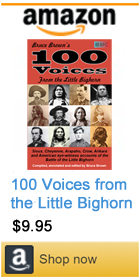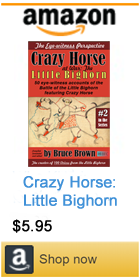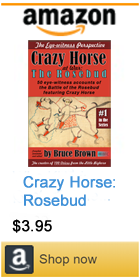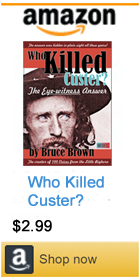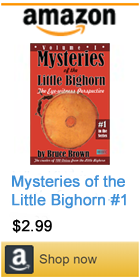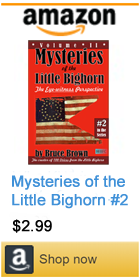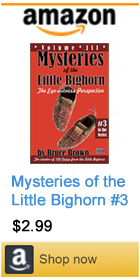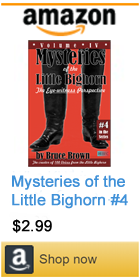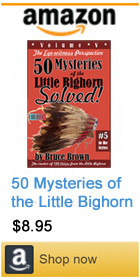|
||||||||||||
Bruce Brown's 100 Voices... He Dog's Story of the Battle #1
HE DOG'S ACCOUNT
I was on reservation before 1876 on the Platte. We (Ogalallas) wintered on the Tongue. Battle March 17, 1876, with Crook (Three Star- Wicokpi Yammi) against Cheyennes, but I was there with a few Sioux. This was a Cheyenne camp under Little Wolf. When fought Crook, Ogalalla village was on Sundance Creek2 not far from Little Bighorn. [Note: this is the Battle of the Rosebud, where Crazy Horse commanded the joint Cheyenne / Sioux force.] A bluff with pines on it near by (this must have been at lone tepee). I lost seven horses in this scrap. The next night we camped on Lodgepole Creek and sent men who got some of these horses back. Indian in lone tepee was a Sans Arc, a brother of Turning Bear. He was shot through bowels in Crook fight.3 [Note: according to Feather Earring, the dead warrior was Old She Bear.] We started out to fight Crook the second time but did not see Crows around and afraid Crows would get at our village, and we turned back. The reason did not pursue Crook was that we were too far from our villages which were not only a long distance off but were strung out over much country. Did not pursue Crook because afraid Crows and Shoshones would get at our vi llage. We saw Crook had a good many Indians. We knew that we had defeated him because he turned back. Moved to Little Bighorn third day after Crook fight. Sioux did not want to fight and so when got away off at Little Bighorn thought would have no more fighting. We had our wives and children with us and had to get buffalo meat for them and wished to be let alone. It has always been an argument among Sioux whether second or third day after we moved camp to Little Bighorn that Sioux party of seven Sioux saw Custer's dust. These Indians did not come back and warn village but made a circle around the soldiers and went on southeast to the agencies. Fast Horn was the Indian whom Varnum saw from Crows Nest and he got back to village only a short time before Reno appeared. Of the seven scouts who discovered Custer, Black Bear and Dirt Kettle were among them. They saw Custer's dust and Custer coming so fast doubted whether they could beat him to village -- so took a look at soldiers and went on toward agencies. Ogalallas were not on Little Bighorn June 25 but back from river northwest of Hunkpapa. Did not expect to fight here as Crook had gone away, and so forth. Brules not on Little Bighorn in village June 25 but over by Ogalalla. Good many Brules there. More than twenty lodges was reported to me. Flying Chaser -- Wakuya Kinyan -- was the head man of Brules but not a big chief. More Hunkpapas than any other tribe. Minneconjou next. Hunk and Blackfeet together had 600 or 700 lodges. Thirty or forty lodges of Santees. Inkpaluta,4 their chief, was there. Just two Arapahoes. (Thinks 1,800 lodges in whole village about right.) Did not see any white man among Sioux. In my camp there was a Canadian half breed who spoke very good English as well as Sioux. When Reno approached, the Hunks went out ahead, mostly on foot, and I was slow in getting my horse. The Hunks went up to point of timber and held the soldiers back. I was on hill to west of Reno's skirmish line, and Indians were getting ready for word to charge in a body on soldiers at timber. Sioux had not all got there yet, but Indians from all tribes -- all that could get horses and get there. Just as we charged, the soldiers left the timber in two bunches on their horses as fast as they could ride up the river. Chased Indian scouts from timber to river also and killed some of them. Saw Benteen coming and quit pursuing Reno. I went back to Hunkpapas camp, and then we looked and saw other soldiers coming on the big hill right over east. [Note: this was Custer's column.] They kept right on down the river and crossed Medicine Tail coulee and onto little rise. (The first rise above flat south of mouth of Medicine Tail) (where Foley found). Pointed distance as same from his office to tank so that it agrees with my map exactly (about 600 ft.). Here Custer's line was scattered all along parallel with river from Foley and Butler. When Custer passed near to Ford B [Note: the ford at Medicine Tail Coulee], he was moving as though to reach the lower end of our camp. (It is my opinion that the 5 men killed on hill by cut bank opposite the village were at the head of the column and were met by Indians moving up the river.) The Indians had left the camp over west to get ready. There was no fighting while Custer down near river but a few shots down there. No general fighting; fifteen or twenty Sioux on east side of river, and some of soldiers replied, but not much shooting there. Did not hear Custer fire any volleys. [Note: Arikara scout Goes Ahead, who was at Medicine Tail Coulee, heard the two signal volleys, as did Edward Godfrey and John Burkman. White Cow Bull was one of the few warriors at the ford [Ford B] when Custer tried to cross. He said he shot an officier was probably Custer in the middle of the river, knocking him from his horse into the water. See Who Killed Custer -- The Eye-Witness Answer for more info.] Says location of Foley is right and he the one who shot himself [suicide]. Before fight started, we drove him up a slope to a ridge (Keogh) and over to other side of it. Soldiers mounted all time and kept going right along. All together all time. Did not fight by companies. Indians all along Custer ridge, and Custer went down along hollow by Keogh. At this time Indians all around. At first gray horses all together but after got on hill mixed up with other horses. Fighting started at Finley and kept up all along. At Keogh is where Crazy Horse charged and broke through and split up soldiers into two bunches. Horses stampeded toward river, getting away from soldiers. There was no charge by Custer's [men] on ridge during fight. Custer's men at end of ridge. Did not run out ofammunition. Found ammunition on dead soldiers. When the men rushed from Custer's last stand toward river, the dismounted ones took to the gully, and the mounted ones tried to get away to south toward Finley. Line H to C mounted soldiers trying to get away when they ran toward gully. Foley rode out of fight from H. (Corroborates twenty-eight dead men in gully.) Fight with Custer did not last much more than an hour, as nearly as I can estimate it. Did not know were fighting Custer. Did not know what soldiers they were. Cheyennes were very brave in this fight and took a leading part. The bloodthirsty ones got tired of scalping before came to Custer group. Never knew about Bustard killed in villages. He knew a Santee who was always with the soldiers. Mitch Bouyer (might also have been Bloody Knife). He was killed, and Sioux recognized his body as a Sioux. After killing all of Pecushi's6 soldiers, we attacked the other soldiers and had them cut off and surrounded on the high bluffs, where we shot at them as they rushed for water. Did not have time to do Reno and Benteen up before Terry came. Had not assistance come to them, we would have worn them out in a few days. Had plenty of ammunition left after June 26. We had ways of getting more, and the ammunition taken from Custer's men we used against the other soldiers. Many had Winchesters, but we had all kinds of guns. The number of Indians killed at Little Bighorn was between thirty and forty. Many more than this were wounded, and some of these died later. After fight, all tribes went up river near to big hills (Big Horn Mts.). All remained together until got to Slim Buttes and there split up, Sitting Bull setting out for Canada. I was in Slim Buttes fight. After camp broken up, Ogalallas, Sans Arc, Minneconjou, and Cheyennes stopped near there, but Hunkpapas went on. The tribe massacred there were Minneconjou, who were out deer hunting. No chief was killed here. The man wounded in bowels and died here was not a chief. He was a Sans Are relative of mine. There were never two American horses to my knowledge. Low Dog was an Ogalalla. Big Foot was a Minneconjou. Black Twin was not in fight. Died in 1875. Kicking Bear was not a subchief. Crazy Horse and Big Road the principal chiefs [of the Oglalas]. Red Cloud was an Ogalalla born. Walter Mason Camp's Notes: 1. Walter Camp field notes, folder 55, BYU Library. 2. Also Ash Creek, Reno Creek and Benteen Creek. 3. He Dog is here referring to the fight with Crook on the Rosebud on June 17. 4. Inkpaluta, or more commonly Inkpaduta, was a Santee Sioux noted for his depredations in Iowa, Minnesota, and Dakota in the 1860s. 5. Sergeant James Bustard of Company I may have crossed the Little Bighorn at Ford B. It was later claimed that his body was found in the village after the fight. 6. Peoushi - a Sioux name for Lieutenant Colonel George Custer, meaning Long Hair. Custer in '76: Walter Camp's Notes on the Custer Fight, edited by Kenneth Hammer, Brigham Young University Press 1976 p 205 - 208
A long-time friend and ally of Crazy Horse's, He Dog was Short Bull's brother and Amos Bad Heart Bull's uncle. He Dog also gave a briefer and somewhat different account a decade later to Gen. H.L. Scott. He Dog surrendered with Crazy Horse at Ft. Robinson, NE, on May 6, 1877. For more information on Crazy Horse's surrender, please see the Crazy Horse Surrender Register.
|
||||||||||||



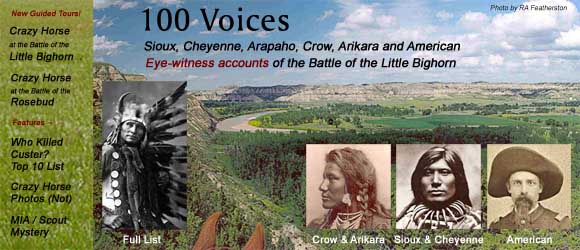
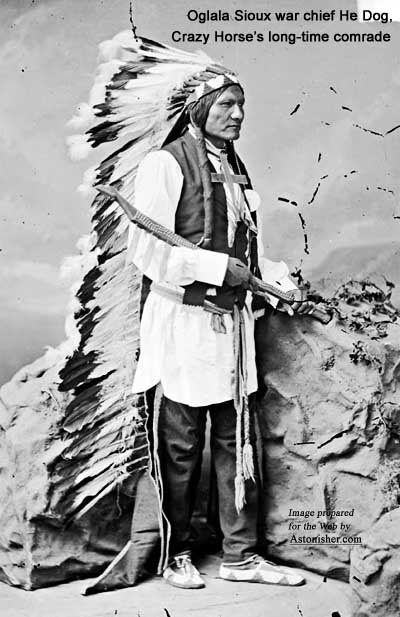 NAME: SUNKA BLOKA... 70 years old.
NAME: SUNKA BLOKA... 70 years old. 